I’ll have the Veal! Preservation with a Can-Do Attitude
Is it practical to retain perishable material and what long-range obligations are required? To find the answers, a collaborative efforts was required, allowing for preservation of our collection of space food.
:focal(455x243:456x244)/https://tf-cmsv2-smithsonianmag-media.s3.amazonaws.com/blogging/featured/Fig_1.jpg)
Conservators and curators at the National Air and Space Museum have puzzled over how to preserve containers of astronaut space food from the Apollo, Shuttle, and Soviet eras. This food was engineered and packaged for consumption in space and portrays the wide range of dietary options for astronauts and their individual preferences. Now corroded, oozing, bulging, and yes, a bit pungent, the cans of food are posing a challenge to the Museum staff tasked with their preservation. We asked ourselves: is it practical to retain perishable materials, what are the long-range obligations required to preserve cans of food, and can those obligations be sustained in order to keep visitors, staff, and the surrounding Museum objects safe? The container vs. the contents—this is a consistent ethical dilemma facing many museum collections stewards. Sometimes saving one means losing the other.
Several problematic cans of food were identified during a condition survey and were sent to the Emil Buehler Conservation Laboratory as part of a Collections Care and Preservation Fund (CCPF) conservation triage project. This project provides emergency care for collection artifacts as they are moved into a new storage facility at the Steven F. Udvar-Hazy Center. Upon initial examination, it was obvious that the steel and aluminum cans from past space programs were severely deteriorated and needed immediate attention.
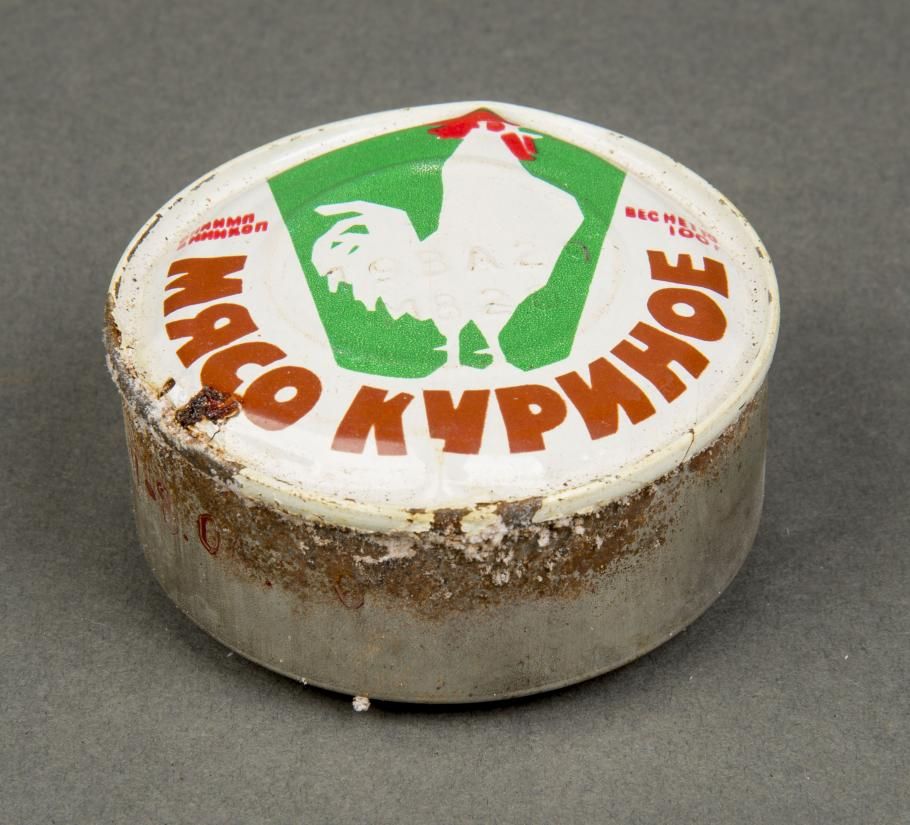
Condition Issues
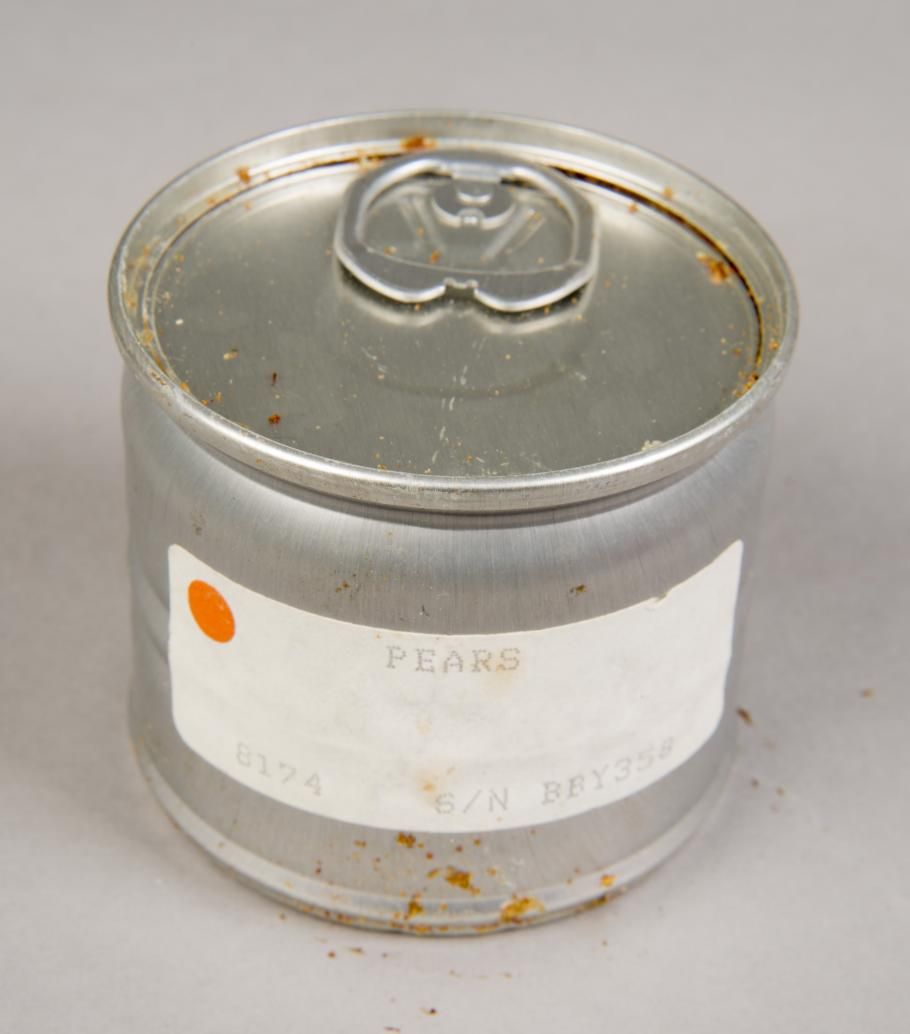
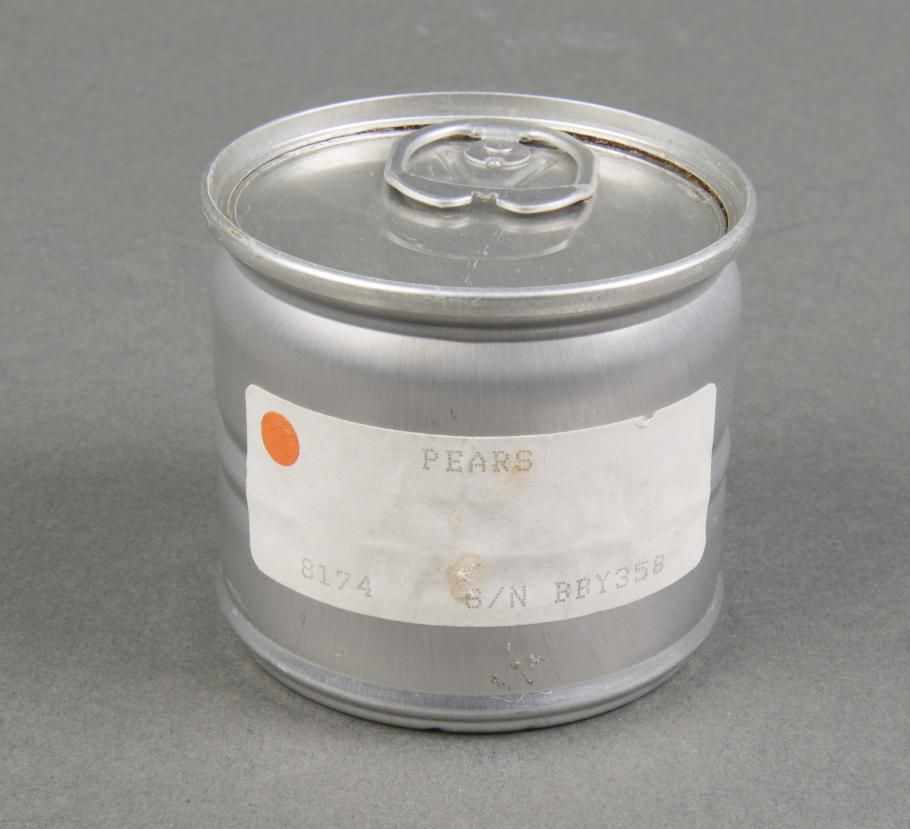
The space food examined as part of this project included two cans of lemon pudding from Skylab 3 (1973) and applesauce and pears from early space shuttle missions (STS-1 in 1981 and STS-27 in 1988). All of the fruit-containing cans were aluminum with pull-tab tops. The aluminum containers of these preserved fruits corroded in scattered pinpoints which allowed the contents to leak out and drip down the sides of the cans. The leaking fruit juices dried in place and sealed over the pinholes, helping prevent bacteria from entering and growing inside the aluminum cans. The weakness in the aluminum cans was the seam of the pull-tab top. One can of lemon pudding arrived in the lab with the lid partially detached and the seam on the other pudding was loosening.

We also examined veal, chicken, and cheese from the Soviet Space Program. The steel cans had corroded and failed at the seams, possibly allowing bacteria to enter. These cans were bulging and had the worst odor, probably because their contents of meat and cheese were more likely to spoil and support bacterial growth.
Non-Destructive Analysis - Can We Tell What’s Inside?
As part of the examination, three cans of Soviet food and one can of tuna from Space Shuttle mission STS-27 were examined using x-radiography to discern if any of the original contents remained and to help determine the condition of the food and its container.

The x-rays revealed significant air pockets inside of the cans. The air pockets indicated that the food had desiccated and was probably exposed to bacteria. This confirmed initial thoughts that the cans’ seals were compromised and that the contents were no longer safe to retain.
Preserving What Is Valued Through Curatorial Consultation
Before deciding on a course of action, the CCPF triage conservation team met with three curators who work closely with space food items: Jennifer Levasseur, Cathleen Lewis, and Valerie Neal. We discussed how the containers are to be used and interpreted in the Museum.
We considered the following questions as part of this project:
- How would interpretation be changed if the food was removed?
- Is there any value in keeping decayed food, versus the value of an empty container?
- Will the food attract pests?
- Can we save both the can and the contents?
- Is it necessary and ethical to remove the food at all?
- What is the most ideal storage environment for these composite materials (food, mixed metals, and paper)?
Curator Jennifer Levasseur pointed out that the ideal situation was to keep both the food and the can as it tells a complete story. But the most severely corroding and bulging cans presented health and safety issues and further deterioration would put the labels of the cans at risk.
Conservator Lauren Horelick considered the loss of the labels as a loss to the object’s intrinsic value, as the labels document what the contents were (or are). Also, since there is documentation from the space programs about how the food was made, it seemed more relevant to preserve the data that pertains to the contents in each can.
Curator Cathleen Lewis also thought that the labels and markings on the Soviet cans were of greater importance than any remaining food. The food was quite obviously spoiled, and she considered it to have little research value.
All of the curators pointed out the importance of the can labels and markings as they represented the manufacturing and engineering process, astronaut meal schedules, and even personal tastes of individual astronauts. Therefore, a unanimous decision was made to prioritize preservation of the labels and the containers over the retention of the food. Two general treatment options for the space food were developed which depended on each can’s degree of preservation. By the end of the project, food was removed from six cans and retained in the three cans that were in the best condition. The section below describes these processes in detail. Lemon pudding will never be the same again….
Treatment Option 1- Removing Spoiled Food
Now that we had identified what we wanted to save and why, we needed to consider the various conditions of the cans. We took an individualized approach to treatment with human safety as the first priority. Bulging cans were opened in the fume hood and the contents removed following CDC protocol.
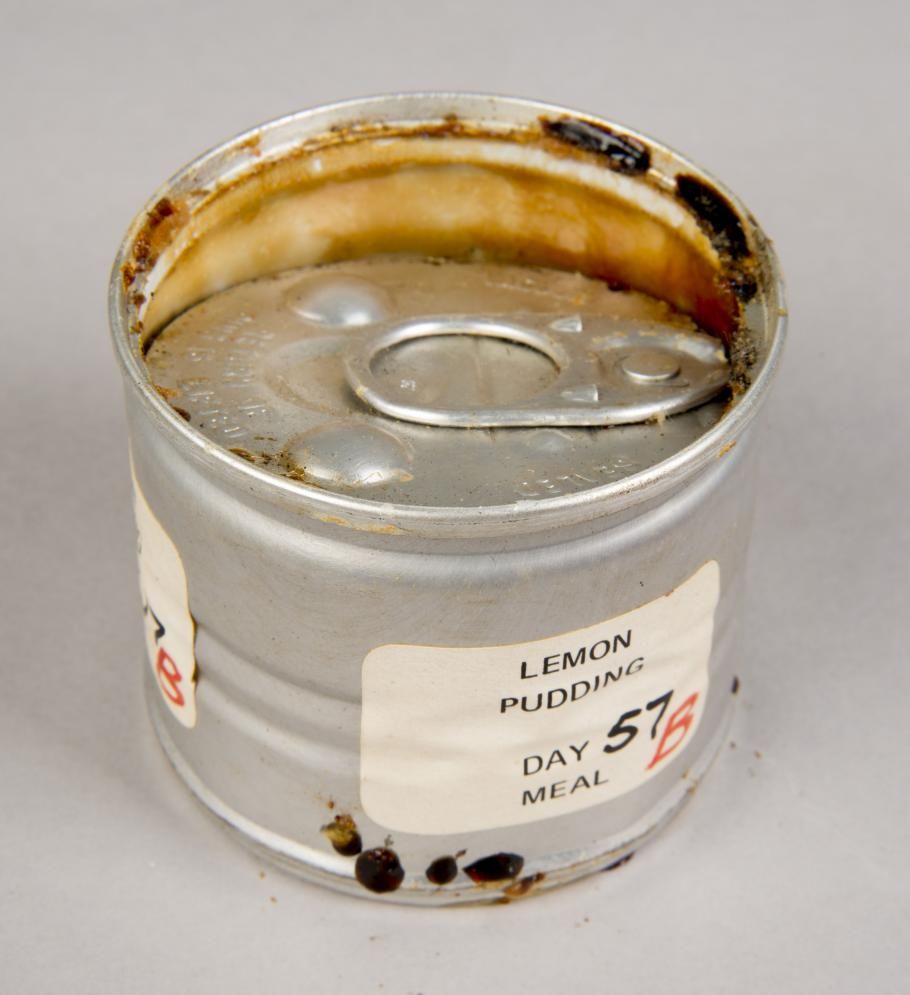
Compromised containers, such as the already-opened can of lemon pudding, were deemed for food removal since the food could no longer be completely contained. Since the pudding was spoiled and degraded, it held little research value to the curator.
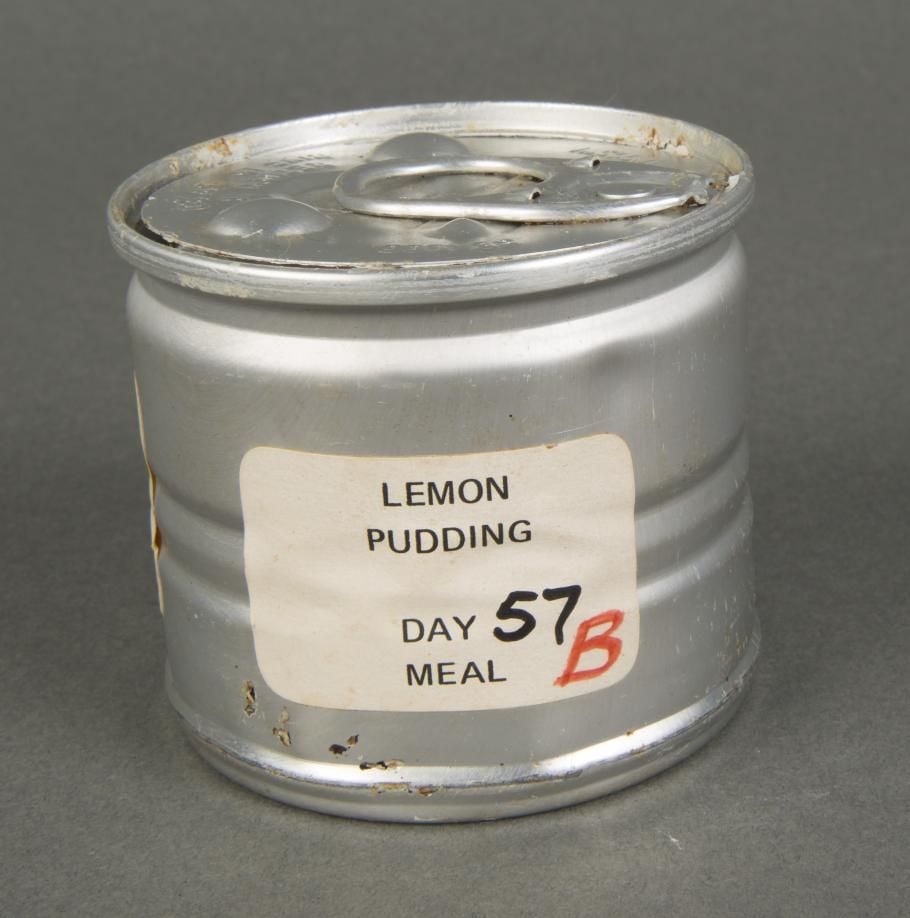
The lemon pudding with the detached lid was removed and the contents were double-bagged for disposal. After treating the corrosion inside and outside of the can, an inert form was made and inserted into the can to support the lid. The lid was secured to the can with Tyvek to prevent its loss and to help retain the original appearance of the can.
We also needed to devise a plan to safely open cans to remove the spoiled food for the lids that were not already compromised.

Conservator Daniel Ravizza proposed opening the cans from the bottom to allow them to appear intact for exhibition and to retain any painted labels or marks on the tops. Ravizza’s research turned up a design for a bacteriological can opener used by the FDA to open and analyze cans of spoiled food. The beauty of the bacteriological can opener is that it can be used to open the can without disturbing the original double seam of the can’s lid. This enabled the opening of the cans inconspicuously from the bottom. While Ravizza made a jig to hold the can in place and protect its surface, museum specialist Gary Gordon used illustrations of bacteriological can openers and his machining skills to fabricate the can opener.


Since the original paper labels on the steel cans were of primary value, they were removed prior to opening the cans. This was partly to help avoid damage to the paper during the removal of the food, but also to enable removal of any corrosion between the label and the surface of the can.
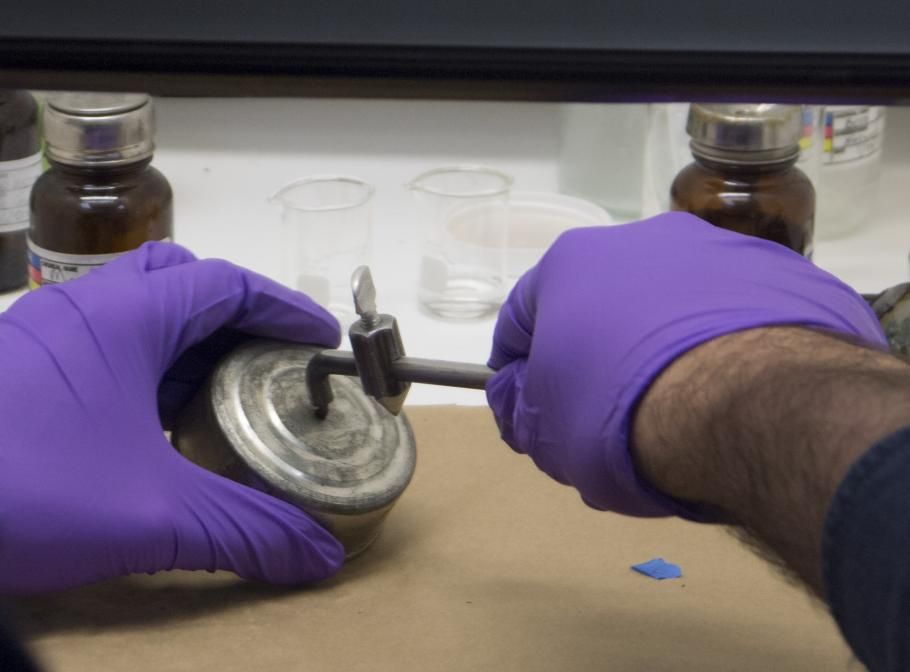
Working in a fume hood, Ravizza punctured a hole in the center of the bottom of the Soviet cheese can with an awl, allowing the gas, which had been causing the bulge, to escape. He inserted the tip of the can opener into the hole and lowered the cutting edge until it punctured the can’s surface, then gently pulled it around the circumference of the can until the bottom detached.
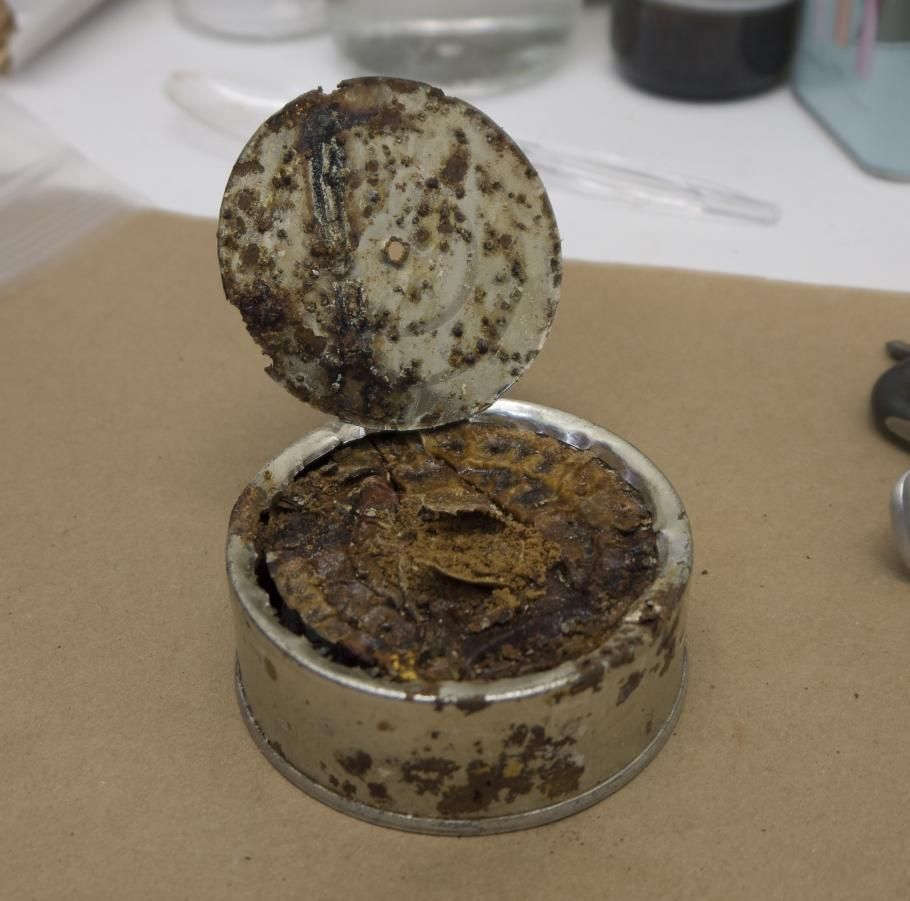
The contents, shown above, were scooped into a plastic zipper storage bag, sealed, and then placed inside another bag and disposed of as quickly as possible.

Cortec VpCI 426, a dilute phosphoric acid solution with corrosion inhibitors, was used to help remove and passivate the corrosion. After the corrosion was treated, the paper label was re-attached to the can (see above image).
Treatment Option 2: Minimal Intervention To Keep Food And Its Associated Containers

